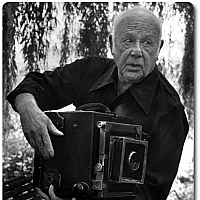
© Paul Strand - Young Boy, Gondeville, Charente, France, 1951 Gelatin-silver print, 19.4 × 24.4 cm Philadelphia Museum of Art, The Paul Strand Collection
Expositions du 7/3/2015 au 17/5/2015 Terminé
Fotomuseum Winterthur Grüzenstrasse 44+45 CH-8400 Zürich Suisse
Fotomuseum Winterthur presents the first major retrospective in Europe of the work of Paul Strand (1890–1976), one of the great modernist photographers of the twentieth century. Fotomuseum Winterthur Grüzenstrasse 44+45 CH-8400 Zürich Suisse
Drawing from a recent major acquisition of 3,000 prints by the Philadelphia Museum of Art, the exhibition shows the evolution of Strand's work over six decades. It reveals the multiplicity of his practice, from his early efforts to secure photography's position as a modernist art form, to his embrace of film-making, to his powerful evocation of people and place in his post-war photo books. Strand is revealed as a complex and contradictory figure: a stubborn aesthete, a communist sympathiser and a pastoralist motivated by a strong sense of social purpose.

© Paul Strand - Blind Woman, New York, 1916
Gelatin-silver print, 32.4 × 24.8 cm
Colecciones FUNDACIÓN MAPFRE
The exhibition begins with Strand's rapid mastery of the prevailing Pictorialist style of the 1910s and his growing interest a few years later in abstraction. We see him attempting to incorporate into photography some of the key lessons of contemporary art, especially Cubism and the work of American artists, championed by Alfred Stieglitz, including Georgia O’Keeffe. At the same time, Strand began to explore urban subject matter, including a remarkable series of close-up portraits of people taken anonymously on the streets of New York. He was investigating the capacity of the camera to record modern life and was particularly interested in its ability mechanically to capture mesmerizing detail. The exhibition includes Strand's first short film, Manhatta (1921), a 'city symphony' dedicated to New York, made together with the artist Charles Sheeler. At once romantic and highly formal, it is considered the first American avant-garde film.
Strand was always interested in travel and in particular the capacity of the camera to reveal the qualities of place and events that would otherwise not be encountered. Between 1932 and 1934 he photographed in Mexico, a country which had a profound effect on him, deepening his engagement with the politics of the left. Here he made a remarkable series of portraits, placing a prism on the lens of his Graflex camera so as to make images surreptitiously. Strand was also interested in the context of Mexican peasant life, making an equally remarkable series of images of bultos, the carved and painted religious figures in Mexican churches. Strand's romantic anti-modernity begins to be articulated in these images, an effort to articulate a quality of life that he felt was being lost.

© Paul Strand - Toward the Sugar House, Vermont, 1944
Gelatin-silver print, 24.4 × 19.4 cm
Philadelphia Museum of Art, The Paul Strand Collection

